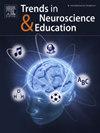In-service teachers’ neuroscience literacy in Hungary: A large-scale cross-sectional study
IF 3
Q2 NEUROSCIENCES
引用次数: 0
Abstract
Background
This is the first study that assesses neuroliteracy, namely the prevalence of neuromyths (NMs) and general knowledge about the brain (GKAB) among Hungarian in-service teachers.
Method
Participants (n = 734) completed an online survey, adapted from a widely used neuroliteracy questionnaire. A scoping review was conducted for international comparison. Associations between prevalence of NMs and predictor factors were analyzed by logistic regression.
Results
The NM error score was 59.7 %, while the correct response score to GKAB was 77.1 %. Compared with other countries, we found the fifth highest level of NM endorsement, but the third most favorable score in GKAB. Acceptance of NMs was significantly associated with reading scientific journals and perceived neuroliteracy.
Conclusion
Hungarian in-service teachers are more likely to believe in neuromyths (especially those related to motor functions) compared with most other countries. Further studies should investigate the impact of the prevalence of motor therapies on the belief in NMs.
匈牙利在职教师神经科学素养:一项大规模横断面研究
这是第一项评估神经素养的研究,即匈牙利在职教师中神经神话(NMs)和大脑常识(GKAB)的流行程度。方法参与者(n = 734)完成了一项在线调查,该调查改编自广泛使用的神经素养问卷。为进行国际比较进行了范围审查。采用logistic回归分析NMs患病率与预测因素之间的关系。结果NM的错误评分为59.7%,而GKAB的正确反应评分为77.1%。与其他国家相比,我们发现NM的认可水平最高,但在GKAB上得分最高,排名第三。接受NMs与阅读科学期刊和感知神经素养显著相关。结论匈牙利在职教师比其他国家的教师更容易相信神经神话(尤其是与运动功能有关的神话)。进一步的研究应该调查运动疗法的流行对NMs信念的影响。
本文章由计算机程序翻译,如有差异,请以英文原文为准。
求助全文
约1分钟内获得全文
求助全文
来源期刊

Trends in Neuroscience and Education
NEUROSCIENCES-
CiteScore
6.30
自引率
6.10%
发文量
22
审稿时长
65 days
 求助内容:
求助内容: 应助结果提醒方式:
应助结果提醒方式:


